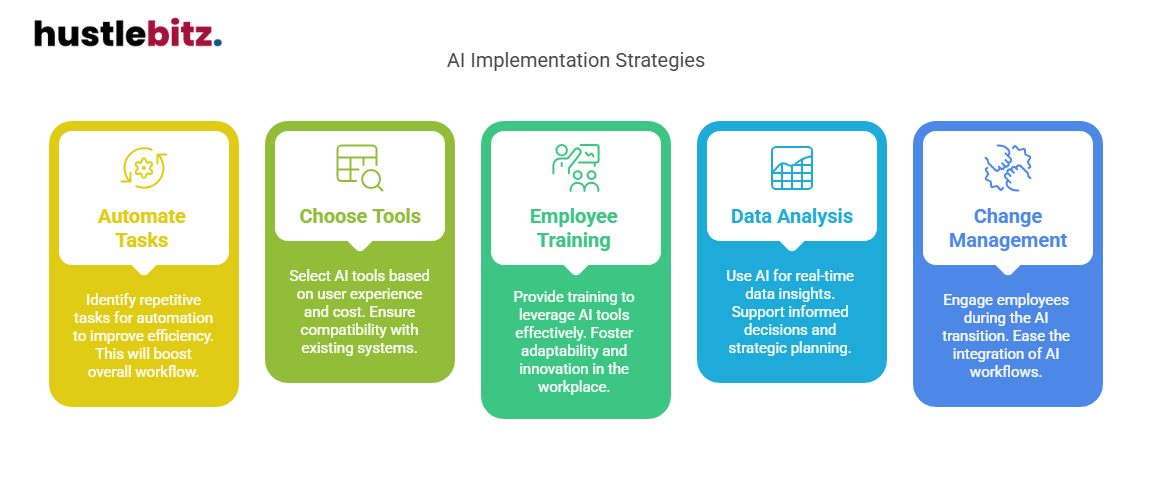Leveraging AI tools can greatly optimize your workflow by automating everyday tasks like data entry and report generation, allowing your team to focus on more strategic efforts. Through the analysis of large datasets, AI supports decision-making by delivering valuable insights that improve operational efficiency. Additionally, AI enhances team communication by minimizing bottlenecks and boosting collaboration. When selecting AI tools, it’s important to consider factors like user experience, cost-effectiveness, and integration potential. To fully capitalize on AI’s benefits, organizations should prioritize employee training and address any ethical implications. Embracing AI can transform your organization’s agility and effectiveness, positioning it for success in today’s fast-paced business landscape. There’s so much more to uncover on this transformative journey.
Key Takeaways
- Identify and automate repetitive tasks such as data entry and email management to boost overall workflow efficiency.
- Choose AI tools based on factors like user experience, cost-effectiveness, and compatibility with current systems to guarantee seamless integration.
- Offer comprehensive employee training to fully leverage AI tools and foster a culture of adaptability and innovation.
- Implement AI-powered data analysis to deliver real-time insights, supporting informed decision-making and strategic planning.
- Adopt change management strategies to engage employees and ease the transition to AI-integrated workflows.

Understanding AI Tools
AI tools are advanced software applications designed to boost productivity and streamline operations across various industries by utilizing sophisticated algorithms and data analytics. These tools have impressive capabilities, allowing businesses to analyze large datasets, automate routine tasks, and derive insights that were previously out of reach.
However, it is crucial to recognize the limitations of AI, such as its inability to fully comprehend human emotions, along with ethical concerns and the need for human oversight in decision-making processes. As businesses increasingly realize AI’s potential, AI adoption has become a key strategic priority. Many organizations are incorporating AI to enhance efficiency and innovation, gaining a competitive edge in their respective markets.
That said, the journey to AI integration is not without challenges. Companies must address AI ethics, ensuring that implementations are free from bias and respect privacy rights. Establishing robust ethical frameworks is essential for promoting responsible AI use and fostering stakeholder trust.
Looking ahead to the AI future, advancements in areas like machine learning, natural language processing, and robotics are expected to transform industries even further. As AI tools become more advanced, they will drive substantial changes in workflows.
Organizations must remain proactive, continuously evaluating the ethical and operational impacts of AI. By understanding both the capabilities and limitations of AI, businesses can make well-informed decisions, reaping the benefits while maintaining ethical integrity throughout their operations.
Benefits of AI in Workflows
Integrating advanced technology into workflows can significantly enhance productivity, reduce operational costs, and improve overall decision-making quality within organizations. The AI advantages are manifold, touching various aspects of business operations.
One of the most notable benefits is the productivity boost achieved through task automation. By automating repetitive and mundane tasks, employees can redirect their focus towards more strategic activities, thus maximizing their efficiency and output.
Moreover, AI-driven tools provide robust decision support, enabling organizations to make data-informed choices with greater speed and accuracy. These tools analyze vast amounts of information rapidly, identifying patterns and trends that might be overlooked by human analysts. This not only facilitates timely responses to market changes but also supports long-term strategic planning.
Workflow enhancement is another critical area where AI proves invaluable. With intelligent algorithms and machine learning capabilities, AI systems can streamline processes, ensuring that resources are allocated optimally. This leads to reduced bottlenecks and smoother communication across teams, fostering a collaborative environment.
Additionally, the integration of AI tools can lead to significant cost reductions by minimizing errors and inefficiencies inherent in manual processes. As organizations adopt these technologies, they pave the way for a more agile and resilient workforce capable of adapting to evolving market demands.
Identifying Repetitive Tasks

Recognizing and categorizing repetitive tasks within workflows is a vital step in harnessing the full potential of AI tools for enhanced productivity. By identifying these tasks, organizations can streamline their operations through task automation, leading to significant workflow efficiency and productivity enhancement. Repetitive processes often consume valuable time and resources that could be better allocated elsewhere.
To effectively identify repetitive tasks, consider the following:
- Routine Data Entry: Tasks that require consistent input of data across various platforms.
- Email Management: Sorting, responding, and categorizing emails can be automated to free up time for more critical activities.
- Report Generation: Gathering data and creating reports can often follow a standard format, making them ideal candidates for automation.
- Appointment Scheduling: Repetitive scheduling tasks can be streamlined using AI, reducing the back-and-forth communication typically involved.
Selecting the Right AI Tools

Choosing the appropriate AI tools is essential for maximizing productivity and ensuring seamless integration into existing workflows.
The selection process begins with a comprehensive tool comparison, allowing organizations to evaluate various options based on their unique requirements. Key factors to consider include user experience, as tools that are intuitive and easy to navigate often lead to quicker adoption and enhanced productivity among team members.
Cost effectiveness is another critical aspect, as organizations must assess both the initial investment and ongoing expenses associated with each AI tool. A tool that appears affordable may entail hidden costs in terms of training, maintenance, or potential disruptions during implementation. Therefore, it’s imperative to analyze the total cost of ownership when making decisions.
Organizations should also be aware of potential implementation challenges that can arise when introducing new AI tools. These challenges can range from technical compatibility issues to resistance from staff who are accustomed to traditional methods. Addressing these concerns proactively can mitigate disruptions and ensure a smoother transition.
Lastly, it’s vital to keep an eye on future trends in AI technology. As innovations continue to emerge, selecting tools that not only meet current needs but also offer scalability and adaptability will position organizations for long-term success.
Integrating AI Into Daily Operations

Incorporating AI into daily operations streamlines processes, enhances decision-making, and boosts overall efficiency across various business functions.
To successfully integrate AI, organizations must adopt comprehensive AI implementation strategies that align with their unique operational needs and goals. This involves not only selecting appropriate AI tools but also ensuring their compatibility with existing systems.
To facilitate a smooth transition, businesses should consider the following critical aspects:
- Employee Training Programs: Equip staff with the knowledge and skills necessary to effectively utilize AI tools, ensuring they feel confident in leveraging new technologies.
- Ethical AI Considerations: Implement frameworks that address potential biases and ethical dilemmas associated with AI, fostering trust and accountability within the organization.
- AI Tool Compatibility: Assess how new AI solutions will interact with current software and hardware to avoid disruptions in workflow and maintain operational continuity.
- Change Management Processes: Develop strategies to manage the cultural and procedural shifts that come with AI adoption, ensuring that employees are engaged and onboard with the transformation.
Utilizing AI for Data Analysis

Harnessing AI for data analysis enables organizations to uncover valuable insights from vast datasets, ultimately driving informed decision-making and strategic planning.
The integration of machine learning algorithms facilitates the identification of patterns and trends that may go unnoticed through traditional analysis methods. By employing predictive analytics applications, organizations can anticipate future outcomes, thereby enhancing their ability to respond proactively to market changes.
Moreover, the implementation of data cleaning automation is crucial for ensuring the accuracy and reliability of datasets. This process minimizes the time spent on manual data preparation, allowing analysts to focus on interpreting results rather than correcting errors.
The use of advanced data visualization techniques further enhances understanding by transforming complex data into intuitive visual formats, making insights accessible to stakeholders at all levels.
Real-time insights generation is another significant benefit of utilizing AI in data analysis. Organizations can leverage AI tools to process and analyze data as it is generated, ensuring that decision-makers have the most current information at their fingertips.
This capability is essential in today’s fast-paced business environment, where timely decisions can provide a competitive edge.
AI for Streamlining Workflows

AI’s ability to automate routine tasks significantly enhances workflow efficiency, allowing teams to focus on higher-value activities that drive innovation and productivity. As organizations increasingly adopt AI automation trends, they are discovering powerful workflow optimization strategies that not only streamline operations but also foster a collaborative environment.
Implementing AI tools can lead to transformative benefits, including:
- Increased Efficiency: Automation of repetitive tasks reduces time spent on mundane activities, enabling teams to concentrate on strategic initiatives.
- Enhanced Team Collaboration: AI tools facilitate better communication and coordination among team members, breaking down silos and promoting a unified approach to problem-solving.
- AI Driven Decision Making: By harnessing data insights, AI empowers teams to make informed, evidence-based decisions swiftly, enhancing the overall quality of outcomes.
- Future of AI Tools: As technology evolves, businesses that invest in AI will likely stay ahead of the curve, leveraging cutting-edge solutions to maintain a competitive advantage.
The intersection of AI and workflow management is shaping the future of organizational effectiveness. Companies that embrace these advanced technologies are better equipped to adapt to changing market demands and seize new opportunities.
By focusing on enhancing team collaboration and decision-making processes, organizations can unlock the full potential of AI, ensuring sustainable growth and innovation in the years to come.
Ultimately, the integration of AI into workflows not only streamlines operations but also redefines the landscape of work itself.
Final Thoughts
AI tools are transforming business workflows by automating routine tasks, enhancing decision-making through real-time insights, and fostering better team collaboration. To fully leverage these benefits, organizations must focus on employee training, ethical AI practices, and selecting tools that integrate seamlessly with their existing systems. As AI continues to advance, businesses that adapt to these technologies will be better positioned to stay competitive, drive innovation, and achieve long-term success. Thoughtful implementation and an understanding of both AI’s strengths and limitations will be crucial for unlocking its full potential.




